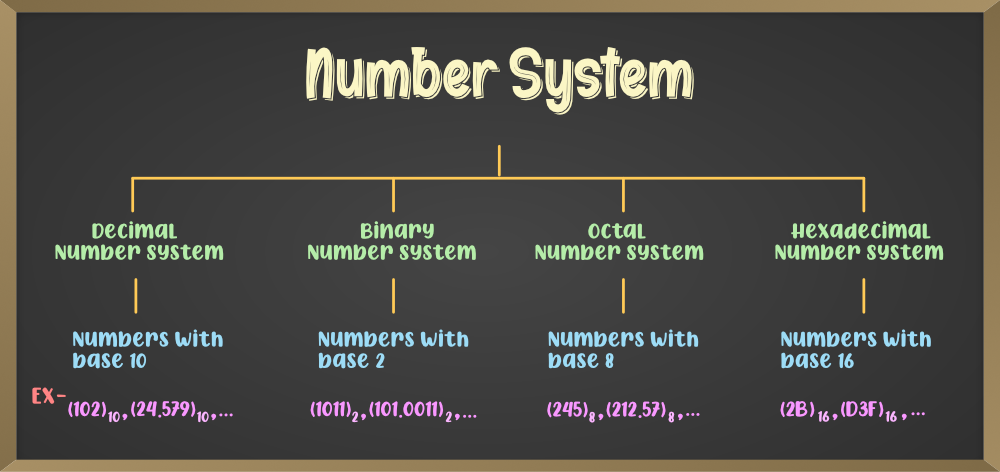
|
|
Hexadecimal Number System is a base-16 numeral system used in diverse fields, especially in computing and digital electronics. It consists of 16 symbols, including numbers 0 to 9 and letters A to F, offering a compact way to represent binary-coded values. The hexadecimal number system is sometimes also represented as, ‘hex’. Number Systems are various ways to use numbers to represent large numbers and information. The hexadecimal number system is introduced to students in class 9. In this article, we will learn about, the Hexadecimal Number System, Hexadecimal Number System Table, Hexadecimal Number System Examples, and Others in detail.  Hexadecimal Number System Table Before starting with the Hexadecimal Number System we first learn about the Number System. Table of Content What is Number System?Number System is a method of representing Numbers and there are various types of the number systems in mathematics that are defined as,
Types of Number SystemsBased on the base value and the number of allowed digits, number systems are of many types. The four common types of Number System are:
Now let’s learn about, Hexadecimal Number in detail. What is Hexadecimal Number System?Hexadecimal is a number system combining “hexa” for 6 and “deci” for 10. It uses 16 digits: 0 to 9 and A to F, where A stands for 10, B for 11, and so on. Similar to the regular decimal system, it counts up to F instead of stopping at 9. Each digit in hexadecimal has a weight 16 times greater than the previous one, following a positional number system. When converting to another system, we multiply each digit by the power of 16 based on its position. For example, in the number 7B3, 7 is multiplied by 16 squared, B by 16 to the power of 1, and 3 by 16 to the power of 0. Facts about Hexadecimal Numbers
Hexadecimal Number System TableFollowing table represents the relationship between hexadecimal number system with decimal as well as binary number system.
Hexadecimal Numbers ConversionsThe hexadecimal number can be easily converted to various other numbers such as, Binary Numbers, Octal Numbers, Decimal Numbers and vice-versa. Now let’s learn about them in detail. Hexadecimal to Decimal ConversionConverting hexadecimal to decimal follows a similar process as before, where each digit is multiplied by the respective power of 16. Example: Convert (A7B)16 to decimal.
Decimal to Hexadecimal ConversionTo convert a decimal number to hexadecimal, we use the base number 16. The process involves dividing the number by 16 repeatedly until the quotient becomes zero. The decimal to hexadecimal number system is shown in the image added below,
Example: Convert (92)10 to hexadecimal. Solution:
Hexadecimal to Octal ConversionTo convert a hexadecimal number to octal, we follow a two-step process: first, convert the hexadecimal number to decimal, and then convert the decimal number to octal. Example: Convert (1F7)16 to Octal. Solution:
Octal to Hexadecimal ConversionThere is a two step process to convert an octal number into hexadecimal: Step 1: Convert Octal to Binary For each octal digit, replace it with its three-digit binary equivalent. Example: Convert (345)8 to binary. Solution:
Example 2: Convert (011100101)2 to hexadecimal. Solution:
Hexadecimal to Binary ConversionConverting hexadecimal to binary involves two methods: one with a conversion table and the other without a conversion table. Method 1: Convert Hexadecimal to Binary with Conversion Table To convert a hexadecimal number to binary using a conversion table, we follow these steps: Example: Convert hexadecimal (4D)16 to binary. Solution:
Method 2: Convert Hexadecimal to Binary without Conversion Table This method involves multiplying each digit by 16(n-1) to obtain the decimal number, and then dividing by 2 until the quotient is zero. Example: Convert hexadecimal (A2)16 to binary. Solution:
Binary to Hexadecimal ConversionTo change binary to hexadecimal, we refer to a conversion table from the previous section. Example: Convert (10111010101)2 to hexadecimal. Solution:
Place Value of Digits in Hexadecimal Number SystemThe numbers in the hexadecimal number system has weightage in powers of 16. The power of 16 increases as the digit is shift towards the left of the number. This is explained by the example as, Example, (AB12)16
Read More, Examples on Hexadecimal Number SystemExample 1: Convert Hexadecimal 1A5 to Decimal Solution:
Example 2: Convert Decimal 315 to Hexadecimal. Solution:
Practice Questions on Hexadecimal Number SystemProblem 1: Convert the hexadecimal number 2A to binary. Problem 2: Convert the binary number 110110 to hexadecimal. Problem 3: Add the hexadecimal numbers 1F and A3. Provide the result in hexadecimal. Problem 4: Subtract the hexadecimal number B6 from D9. Provide the result in hexadecimal. Problem 5: Multiply the hexadecimal number 7E by 3. Provide the result in hexadecimal. Hexadecimal Number System – FAQsWhat is a Hexadecimal Number System?
What are 16 Digits of Hexadecimal Number System?
What is the Use of Hexadecimal Number System?
What is 16 Called in Hexadecimal?
What is 8 in Hexadecimal Number System?
How Many Digits are Used in the Hexadecimal Number System?
Where are Hexadecimal Numbers Used by Programmers?
How Do You Convert a Hexadecimal Number to Binary?
How Do You Convert Binary to Hexadecimal?
|
Reffered: https://www.geeksforgeeks.org
| Mathematics |
Type: | Geek |
Category: | Coding |
Sub Category: | Tutorial |
Uploaded by: | Admin |
Views: | 14 |

